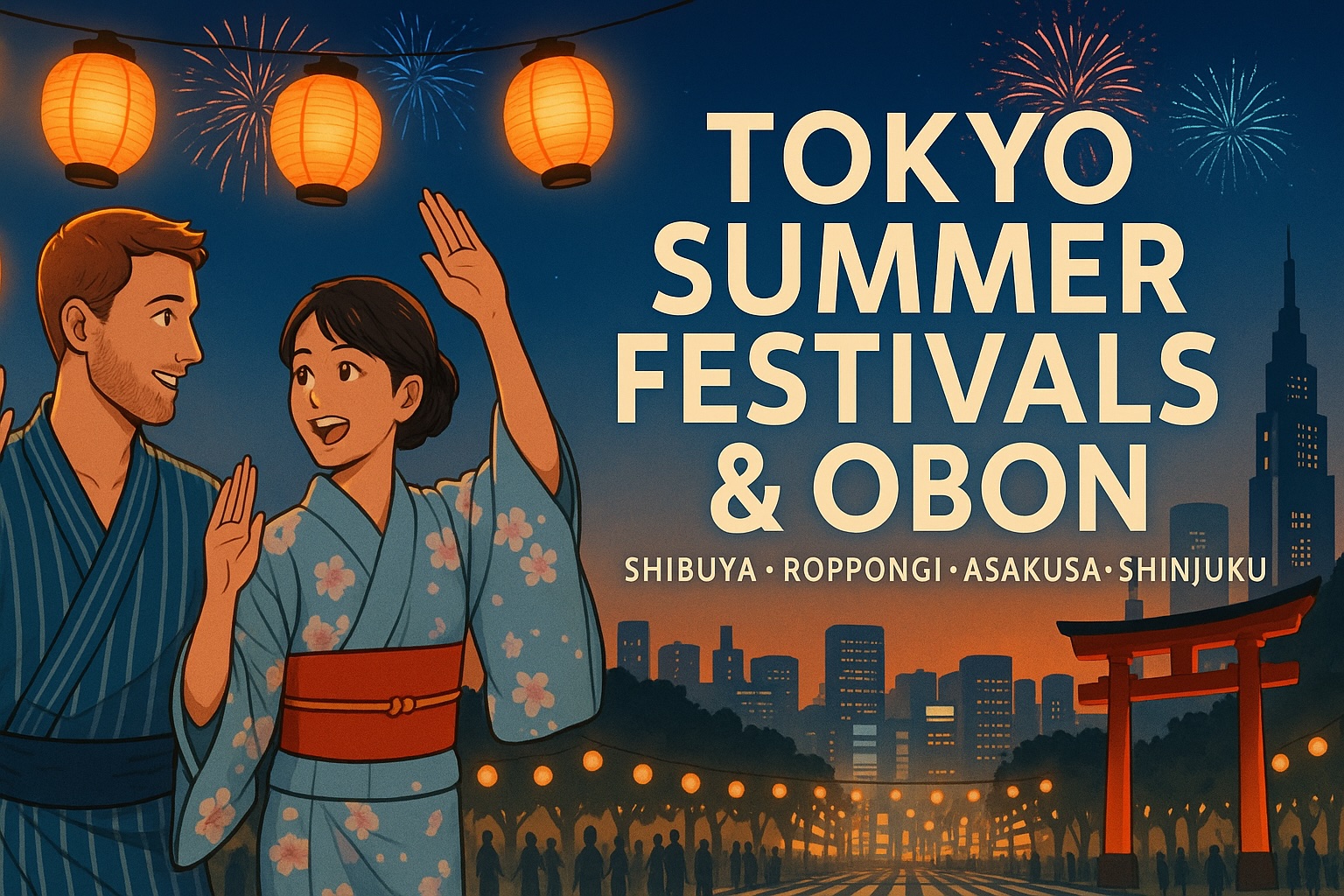- Opening: Walking a City Where Two Seasons Overlap
- Obon Basics: A Summer Built on “Welcoming” and “Sending Off”
- Walking a River of Light: The Afterglow of Yasukuni’s “Mitama”
- A Night When Edo Blooms: Sumida River Fireworks (Held July 26)
- Returning the Light to Water: Sumida River Lantern Floating on August 16
- When the Intersection Becomes a Dance Floor: Shibuya Bon Odori on August 2
- Urban Stagecraft, Soft Landing: Roppongi Hills Bon Odori on August 22–24
- Shade, Wind, and a Low Drum: Shinjuku Chuo Park Bon Odori on August 23–24
- “Another Shinjuku” Option: Kabukicho BON ODORI on August 16
- How to Enter the Circle: Three Laps, One Body
- What to Wear, How to Keep Cool: Yukata or Sneakers—Both Are Right
- Sensing Tokyo with Ears and Nose: Drums, Incense, Stalls, Night Wind
- Weaving a Day: Water → Streets → Shade → Night Lights
- Crowds, Read Carefully—And Make Tiny Retreats
- Pocket Phrases for Meeting People
- Closing: Prayer and Play, Lived at the Same Time
Opening: Walking a City Where Two Seasons Overlap
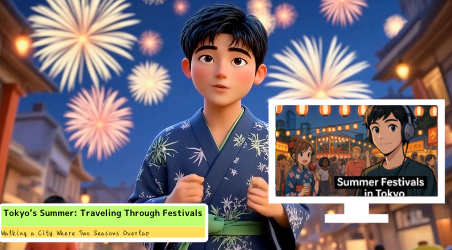
It’s July 27, 2025. In Tokyo, the quiet, inward season of Obon—when families “welcome and see off” their ancestors—sits on the same calendar as the outward, pulsing season of summer festivals.
In Tokyo, many neighborhoods observe Obon in July, while much of Japan does so in August. That means if you’re here now, you’re carrying the soft afterglow of remembrance right into the weeks when the city starts to dance.
The trick to savoring Tokyo’s summer is to move back and forth between those two temperatures: the hush of prayer and the heat of celebration. Spread a map on the table and you’ll see how a single summer splits into many faces: the river wind of Asakusa, the intersection glow of Shibuya, the arena-like plaza of Roppongi, the tree-shaded bass of Shinjuku Central Park.
Same season, different expressions. Today we’ll walk that gradient together, in a relaxed, radio-style narration.
Obon Basics: A Summer Built on “Welcoming” and “Sending Off”
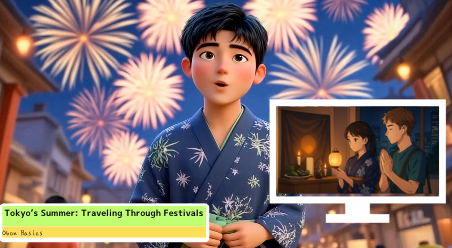
Obon is a Buddhist season when families invite ancestors home and then escort them back. You light a small flame to guide them in, prepare a simple altar, hang lanterns to show the way, and visit graves to say thank you.
Dates vary by region, but at the core is respect for those who are absent yet still present in memory. The lively lines of lanterns and the big circles of Bon Odori you see in the streets are like flowers blooming from that quiet root.
If you hold that image in mind, the same festival scene suddenly has depth: the sound, the scent, the way air moves through a crowd.
Try this on your trip—one night, crack your hotel window, pause the air conditioner, and just listen. You’ll notice the thrum of drums somewhere far off and the soft clink of a wind chime. Even in a city of millions, someone’s family ritual is still happening, quietly, almost next to you.
Walking a River of Light: The Afterglow of Yasukuni’s “Mitama”
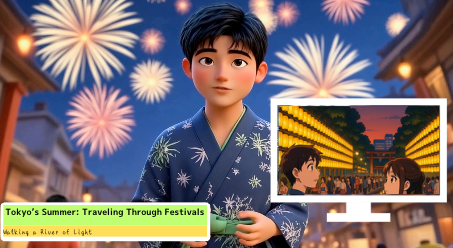
One symbol of Tokyo’s July Obon is Yasukuni Shrine’s summer nights, when thousands of lanterns line the approach and a golden river of light runs straight into the sky. The bustle of food stalls and stage performances sits right beside a more solemn current of remembrance—that coexistence is the heart of the scene.
The best way to take it in is to stop moving for a moment and listen. Cicadas spiraling in heat, the scrape of fans against palms, the low echo of drums, the common rhythm of people breathing together.
Layer those sounds and you’ll feel “Tokyo in summer” standing up around you. If you missed it this year, mark the same mid-July dates for next year and plan an evening breeze in Kudanshita. The light is beautiful, but the air itself is what you’ll remember.
A Night When Edo Blooms: Sumida River Fireworks (Held July 26)
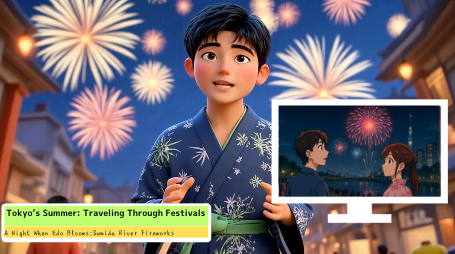
Tokyo’s classic fireworks bloomed last night. Two launch sites span the river between Asakusa and Mukojima, turning the water into a mirror and the old downtown into a living stage.
If you aim for next year, check the wind first and design a “back-step route” home that avoids the nearest station. Streets often go one-way under crowd control, and true sit-down spots are scarce; this is a show best watched on the move, catching sudden clearings as alleys open onto the river.
If your yukata feels too warm, duck into a convenience store or café for a three-minute cool-down, then merge back into the stream. Those tiny retreats are the difference between fading early and feeling fresh for the final barrage.
Returning the Light to Water: Sumida River Lantern Floating on August 16
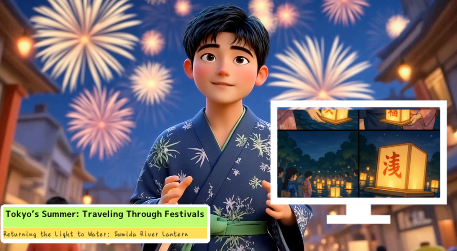
There’s a way to “mute” the summer noise for a while: float a lantern. On the evening of August 16, near Azuma-bashi, people set paper lanterns onto the river one by one.
Points of light become lines, lines become planes, and then the whole scene dissolves gently into night. It’s less a photo than a gesture you’ll feel in your body. Write a short message in any language; meaning travels through the hands.
Choose your side—Asakusa or Sumida—based on where you’re staying and how you prefer to walk home, and let dusk set the tempo. The breeze decides how fast the lights drift; that unpredictability is part of its grace.
When the Intersection Becomes a Dance Floor: Shibuya Bon Odori on August 2
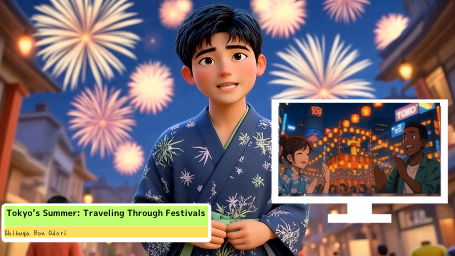
Shibuya’s magic is simple: put a dance tower in the heart of the city and the streets remember how to breathe.
As evening falls, car lanes yield to footsteps, and classic songs like “Tokyo Ondo” mingle with Shibuya originals and even a few pop tracks. If you’re new to Bon Odori, don’t worry. The dancers atop the tower are your best teachers. First lap: just watch.
Second lap: mirror the hands. Third lap: add the feet. In three minutes you belong to the circle, and any language barrier falls away.
When you leave, skip Shibuya Station if it’s packed; walk fifteen minutes toward Shinsen or Omotesando and board there. You’ll be surprised how calm the ride feels.
Urban Stagecraft, Soft Landing: Roppongi Hills Bon Odori on August 22–24
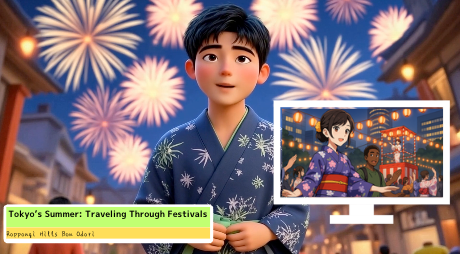
Roppongi frames the dance with city light. The plaza glows, the sound is well-tuned, and food stalls open early so you can take breaks before and after the main dance window.
Even wrapped in polished lighting and sound, stepping into the circle shrinks the city back to neighborhood scale—that’s the Roppongi trick.
A yukata with sneakers is absolutely fine; the right outfit is the one you can move in. Expect a steady breeze between tall buildings.
Fan yourself, carry a small towel, and schedule brief indoor cool-downs so you can dance through to the end feeling light.
Shade, Wind, and a Low Drum: Shinjuku Chuo Park Bon Odori on August 23–24
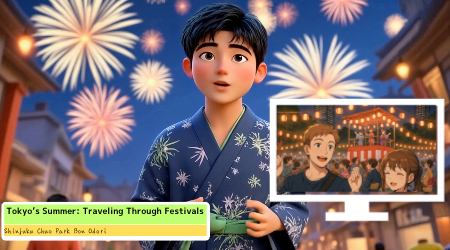
At the foot of skyscrapers, Shinjuku Central Park is all about the bass of the drum folding into the trees. Evening brings food stalls and the dance circle up at the same time, and the grove turns into a natural hall where sound rounds off and carries.
The main area—Fanmore Time Plaza—sits beside open grass, which makes it easy to step away and rest, then slip back into the ring.
Many stalls prefer cash, so bring coins. Families, first-timers, and solo travelers will all feel comfortable here. If your hotel is in Shinjuku, this can be your “base camp” night: easy access, easy exit, and a night wind that cools the city’s heat just enough.
“Another Shinjuku” Option: Kabukicho BON ODORI on August 16
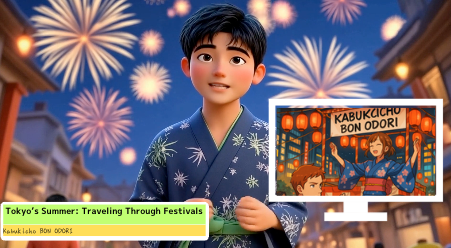
If you want a pop-forward take, Kabukicho’s Cinecity Square offers a lighter, playful rhythm. Classic tunes share space with danceable pop sets guided by on-site hosts, so beginners can jump in quickly.
Compared with Shibuya, the flow is a bit less intense; compared with Roppongi, the vibe is less formal. Food smells, neon colors, and the thump of drums cross in the air, and the circle grows and shrinks like a friendly tide.
Even a simple handclap on the chorus counts as participation—that’s the spirit here.
How to Enter the Circle: Three Laps, One Body
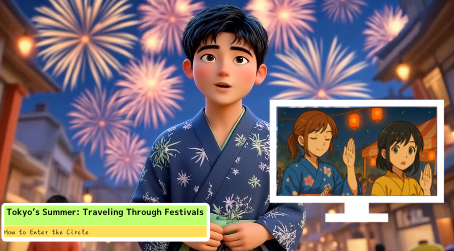
Bon Odori isn’t a competition. Drop your gaze to hip level, release your shoulders, and open your hands like a fan to “make flow.” First lap: observe. Second: hands only. Third: add your feet. You’ll find your breathing syncing with strangers before you know it.
On pop tracks, lean into the groove; on classic sets, respect the hand shapes and the pauses between phrases—the “ma,” the meaningful space.
If someone asks for tips in English, smile and say, “Follow the hands, not the feet.” Once your hands find the rhythm, your body will follow.
What to Wear, How to Keep Cool: Yukata or Sneakers—Both Are Right
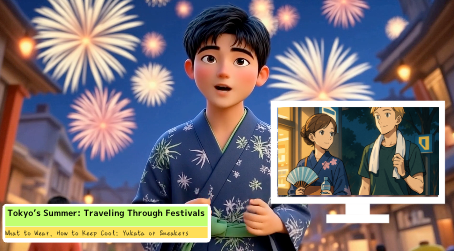
Yukata rentals with dressing and simple hair styling are easy to find around Asakusa, Ueno, and Nihonbashi, but remember: you’ll sweat more than you expect.
If geta sandals worry you, pair a yukata with comfortable sneakers—the “Tokyo mix.” Carry a fan, a small towel, and a 500 ml bottle.
Build a habit of fifteen-minute cool-downs in shade or indoors. Keep your hands free: a small pocketable camera or phone beats a heavy strap around your neck. Two free hands make all the difference when the chorus hits.
Sensing Tokyo with Ears and Nose: Drums, Incense, Stalls, Night Wind
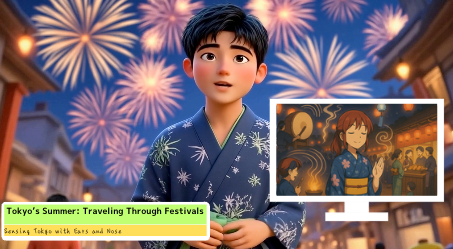
Eyes get the headlines, but the core of a festival sits in sound and scent. The drum’s low note returning through the ground.
A wisp of incense loosening in the wind. Sauce rising off a hot griddle. A bell’s bright ring cutting the humid air. Step half a pace out of the crowd and close your eyes for ten seconds. You’ll feel how prayer and play live side by side here.
Those ten seconds can hold more memory than a thousand photos.
Weaving a Day: Water → Streets → Shade → Night Lights
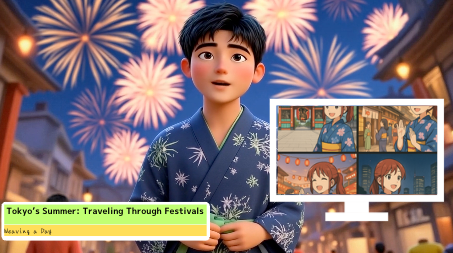
Morning in Asakusa, drifting through Senso-ji to the river park; let the water wind set your body clock. Afternoon in the alleys of Nihonbashi or the old downtown, where you can still catch everyday life wearing a festival’s after-image—stray lanterns, paper fans in a shop window.
At dusk, join the tower in Shibuya as the streets decide to dance. When the skyline starts to glow, slide to Roppongi for the urban set.
If you’re here on a late-August weekend, end under the trees at Shinjuku Central Park and let the low drum carry you home.
If you happen to be in Tokyo on August 16, try this ladder: float a lantern in Asakusa to “send,” then cross to Kabukicho to “play.” That contrast is Tokyo at its most Tokyo.
Crowds, Read Carefully—And Make Tiny Retreats
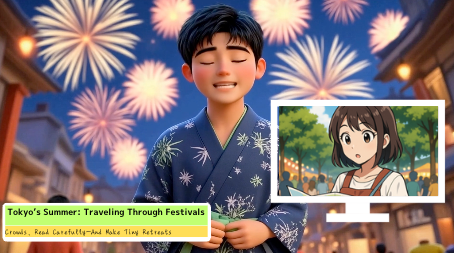
Mid-August draws peak travel across Japan, so trains, planes, and famous spots swell quickly.
On festival days, plan to walk one station beyond the nearest, schedule fifteen-minute indoor cool-downs, keep small cash for stalls, and set a homebound path that cuts against the main flow.
In Shibuya and Asakusa especially, “don’t rush toward the closest station” is a form of self-care. Those small tactics are worth an hour of energy in the bank.
Pocket Phrases for Meeting People
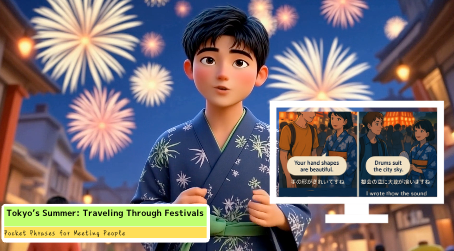
Getting into the circle can start with a line. In Shibuya: “Your hand shapes are beautiful.” In Roppongi: “Drums suit the city sky.” In Shinjuku Central Park: “I love how the sound melts into the trees.”
At the lantern floating: “I wrote a word for someone I miss.” What travels here isn’t perfect grammar—it’s the direction of your heart. Say one sentence, and you might spot the same face in a different circle tomorrow.
Closing: Prayer and Play, Lived at the Same Time
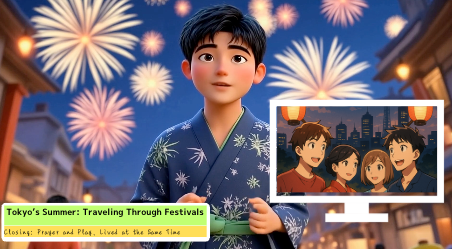
To sum up: in Tokyo, July “welcomes” quietly, August “breathes” through dance, and on the 16th, lights return to water. Shibuya plugs into the present, Roppongi lights the city’s face, and Shinjuku Central Park wraps you in shaded bass.
They’re different radii of one circle. At the center is remembrance for those before us and the shared rhythm of bodies moving together. Shape your circle to match your stay—an evening, a week, or a season.
If you’d like a shoot-ready, day-of script tailored to your exact dates and neighborhoods, tell me when and where. I’ll tune the words to fit “this moment in Tokyo” perfectly.
